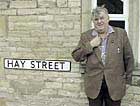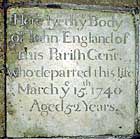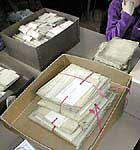

[the England team]
![]()
the England team
 |
the England family, left to right: Jenny, Victoria, Daniel and Bill England |
The Englands are reputedly one of the oldest families in Marshfield. Over the weekend, Jenny and Bill England -- along with the youngest generation of the family, niece and nephew Victoria and Daniel -- will be trying to see how their family history relates to that of the town and, in particular, the malting industry.
how they got on...
HISTORY ROOM
The Englands sat down with David Smith, county and diocesan archivist,
Gloucestershire Record Office, to discuss how to proceed back in time. He suggested that they
go to see Bill's father George (b. 1922).
 |
George England in 1998, see also photos of George as a child |
GEORGE ENGLAND, 10 HAY STREET
Oral history: George talked about his grandfather George (1851-1901) who worked in a malting house. He also brought out
photographs of family members from the first part of this century.
HISTORY ROOM
The Englands began to piece together a family tree, using censuses from 1891, 1871, 1851 and 1831, which gave the order in which
children were born and named George's grandfather as a blacksmith
and publican.
They continued the search back in time using records provided by the Gloucestershire Record Office -- first, the Parish Records Index (dating back to 1529), which had three pages of Englands, and then the parish records themselves. England births, deaths and marriages were consistently listed except for a 41-year gap (1774-1815) when the family became Non-conformist and didn't figure in the (Anglican) parish records.
They examined the 1841 tithe map and award to check out the presence of the Englands in Marshfield, and found them in Plot 114 in the High Street, a shop.
 |
the tombstone of John England (1688-1740) |
GRAVEYARD AND CHURCH
Bill and Jenny searched the graveyard of the parish church of St Mary the Virgin and located the 1901 gravestone of George's grandfather. Inside
the church, they found the tombstone of John England (1688-1740).
HIGH STREET
The Englands located Plot 114 from the tithe map. It's now a house, but subsequently they discovered that it was
once a blacksmith's.
 |
documents in the History Room |
HISTORY ROOM
They consulted local directories to check Englands and their professions; they discovered 'George
England, blacksmith'. As they continued working through the parish records to fill in the family tree, David Smith explained how fathers almost always named their
eldest sons after themselves, but high infant mortality could
confuse this pattern. Jenny and Bill found that many Englands
died of the plague in 1666.
To fill in gaps in the family tree, they consulted the Codrington Archive Catalogue and chose the marriage settlement between John England (who was buried in the church in 1740) and Elizabeth Hammond in 1717. He owned a great deal of land and a malthouse, and appears to be the wealthiest person in the family's history.
Bill and Jenny looked at the Maule Survey map of 1768 and found an England plot between named fields neighbouring the malthouse. They then examined the tithe map to get a more precise bearing as to field boundaries, and transferred this information on to the 1882 Ordnance Survey map. The plot in question had on it a benchmark -- a surveyor's mark cut in a wall, pillar, building, etc., used as a reference point in measuring altitudes -- which should be reproduced on the building itself.
HIGH STREET
Having set out to find the malthouse, the Englands joined the
Whites who were looking for all the malthouses in Marshfield. Jenny and Bill located their malthouse at No. 83, which didn't appear as a malthouse on the 1841 tithe map so
its involvement in malting must have occurred earlier and finished
before 1841. No. 83 is the biggest, richest house in the street,
but the malthouse predated it. Inside, with History Hunters experts Mick Aston and Linda Hall, they found malting tiles,
a well and a millstone.
HISTORY ROOM
Which England was the maltster at No. 83? Jenny and Bill consulted
deeds for the property, which accompanied the 1717 marriage settlement,
and found that it was John England and his eldest son William.
Finally, they examined the 1522 arms survey (muster rolls), which named an England -- the earliest known reference to a member of the family. Eventually they traced the immediate England family back in a continuous line (barring the 41-year gap) to 1559, the year Thomas England was born to William England.